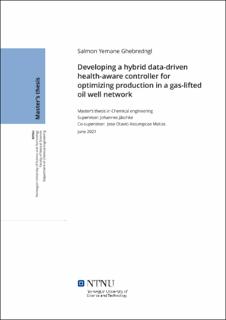| dc.contributor.advisor | Johannes Jåschke | |
| dc.contributor.advisor | Jose Otavio Assumpcao Matias | |
| dc.contributor.author | Salmon Yemane Ghebredngl | |
| dc.date.accessioned | 2022-02-24T18:20:09Z | |
| dc.date.available | 2022-02-24T18:20:09Z | |
| dc.date.issued | 2021 | |
| dc.identifier | no.ntnu:inspera:82941058:18450159 | |
| dc.identifier.uri | https://hdl.handle.net/11250/2981324 | |
| dc.description.abstract | Uventede sammenbrudd og vedlikehold innen offshore oljeproduksjonssystemer er kostbare. Derfor er det nødvendig å ha en vedlikeholdsstrategi som kan sikre pålitelig drift for å opprettholde produksjonskapasiteten. Det er imidlertid viktig å gjøre en avveing mellom det å optimere produksjonen, og det å minimere utstyr degradering. For eksempel er det alltid ønskelig i de fleste oljebrønner å utvinne så mye olje som mulig, noe som skader utstyrets gjenværende levetid. For å unngå slitasje på utstyr, tar ingeniører ofte en konservativ produksjonsstrategi, noe som fører til suboptimal drift og potensielt fortjenestetap. Målet med denne oppgaven er å undersøke muligheten til å automatisere denne prosessen ved å bruke
modellbasert prediktiv regulering (MPC) med integrert helseovervåkingsystem for å redusere konservativ drift ved å aktivt styre degradering av strupeventilen (”choke valve”) og forhindre brudd på helsebegrensninger.
Denne oppgaven utvikler derfor en ny metodikk som tar sikte på å løse det kombinerte problemet. Både den databasert prognose- degraderingsmodellen og prosessmodellen løses gjennom en hybrid datadrevet MPC. I denne kontrollstrukturen bergener kontrolleren de optimale "inputs" ved hjelp av de datadrevne modellene, og "system feedback" i form av diagnostikk legges til for å takle usikkerheten i systemet. Den foreslåtte metoden ble anvendt på en syntetisk case-studie
av subsea oljeproduksjonssystem.
Simuleringsresultatene viser at hybridmodell prediktiv kontroll er et mulig alternativ til å løse kontrollproblemet. Imidlertid ble "plant-model mismatch" observert til å ha en skadelig effekt på ytelsen til HAC-kontrollerne. HAC med NN-modell i både prognostikk og diagnostikk viste en mer signifikant "plant-model mismatch" og hadde kortest ytelsestid, mens HAC uten "plant-model mismatch" var den med lengst ytelsestid. Vi kan si at de hybride HAC-kontrollerne var utsatt for uoverensstemmelse mellom plantemodeller og klarte å minimere konservativitet i produksjonen, men på bekostning av brudd på helse begrensningen som fikk dem til å ha kort ytelsestid og derfor produserte mindre olje totalt. Den overordnede konklusjonen er at ytelsen til hybrid HAC er avhengig av typen datadrevet modell og kvaliteten på "feedback" fra diagnostikk. Videre, kompleksiteten til datadrevne modeller gir ikke nødvendigvis et bedre resultat. | |
| dc.description.abstract | In subsea oil and gas production systems, unexpected breakdown and maintenance interventions are costly. Therefore, a maintenance strategy that can ensure reliable operation is required. However, there is an intuitive trade-off between optimizing production and minimizing equipment degradation. For example, in most oil wells, it is always desirable to extract as much oil as possible, which harms the remaining useful life of the equipment. To avoid equipment wear, engineers often adopt a conservative production strategy, leading to sub-optimal operation and potential profit loss. This thesis proposes a new approach based on forecasting system degradation through a predictive process model. Prognostics and health monitoring (PHM) are then integrated into the control structure to avoid conservative operation by actively steering plant degradation and preventing violation of health constraints.
This thesis develops, therefore, a novel method that aims at solving the combined problem. Both the data-driven degradation model and the process models are solved through hybrid data-driven model predictive control. In this control structure, the controller calculates the optimal inputs using the data-driven models, and system feedback in the form of diagnostics is added to cope with the uncertainties in the system.
The proposed method is applied to a synthetic case study, in which the system of interest is an oil and gas well network with artificial gas- lifting.
The simulation results show that hybrid model predictive control is a possible alternative to solving the control problem. However, the plant-model mismatch was observed to have a detrimental effect on the performance of the HAC controllers. The HAC with NN model in both prognostics and diagnostics showed a more significant plant-model mismatch and had the shortest breakdown time. In contrast, the HAC with no plant-model mismatch was the one with the longest breakdown time. We can say that the hybrid data-driven HAC controllers were prone to plant-model mismatch and managed to minimize conservativeness in production but at the cost of constraint violation which made them break down early and, therefore, produced less oil in total. The overall conclusion is that the performance of hybrid-data-driven HAC is dependent on the type of data-driven model and the quality of the feedback from diagnostics. In addition, the complexity of data-driven models doesn't necessarily give a better result. | |
| dc.language | eng | |
| dc.publisher | NTNU | |
| dc.title | Developing a hybrid data-driven health-aware controller for optimizing production in a gas-lifted oil well network | |
| dc.type | Master thesis | |
